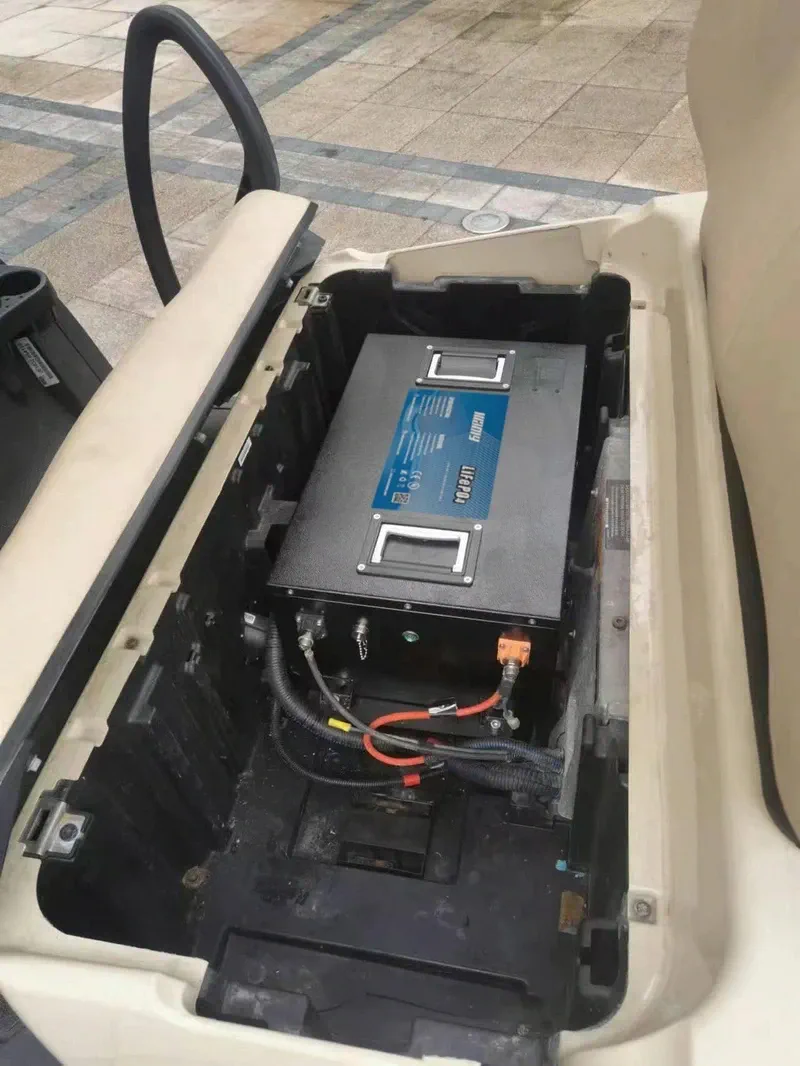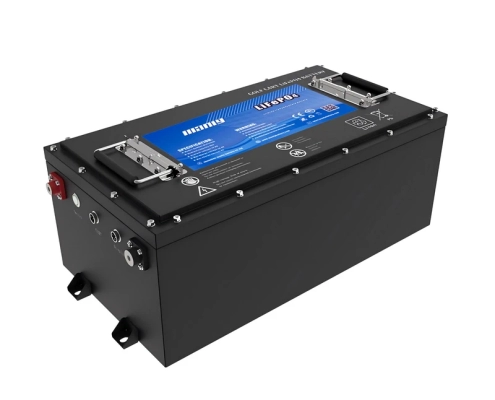2025 How Far Can a Golf Cart Go with a 48 Volt Lithium Battery?
Table of Contents
- 2025 How Far Can a Golf Cart Go with a 48 Volt Lithium Battery?
- Battery Capacity
- Types of Batteries
- Terrain and Distance
- Driving Habits
- Tire Pressure
- Load and Weight
- Weather Conditions
- Battery Age and Health
- Maximum Range on a Full Charge
- Tips to Maximize Golf Cart Range
- Battery Maintenance for Optimal Range
- Charging Time and Range
- Common Misconceptions About Lithium Batteries
- Conclusion
- FAQ
- Learn More About Battery
Electric golf carts are becoming more common on golf courses, communities, and recreational areas. One of the most frequent questions asked is, “How far can a golf cart go on a single charge?” The range of a golf cart is influenced by variables such as battery type, terrain, and driving behavior. This study delves into the impact of these factors on a golf cart’s range and offers strategies for optimization.
Battery Capacity
The battery’s capacity is the main factor influencing how far a golf cart can travel. Most golf carts have 36-volt, 48-volt, or 72 volt lithium batteries. The higher the voltage, the longer the range. For example, a 48-volt lithium battery generally allows for a longer driving distance than a 36-volt system, with ranges typically between 25 and 40 miles.
Lithium batteries, particularly 48-volt ones, are highly favored for their longevity, lightweight, and fast charging capabilities. They offer better performance in colder temperatures, maintaining a steady output even when other batteries may underperform. This should give you confidence in choosing a 48-volt lithium battery for your golf cart.
Types of Batteries
The type of battery powering your golf cart is crucial in determining range. Lead-acid batteries are more affordable but have limited longevity and distance. Alternatively, lithium-ion batteries provide better performance, such as 72 volt lithium batteries for golf carts. Lithium batteries can store energy and deliver it more efficiently, allowing your cart to travel farther on a single charge. Additionally, they recharge faster, which means less downtime between uses. A 36 volt lithium battery for golf cart is also a strong choice, offering longer-lasting power and less frequent maintenance than traditional batteries.
Comparing Lead-Acid and Lithium Batteries
Comparing lead-acid and lithium batteries requires a comprehensive assessment of their strengths and weaknesses based on the precise technical specifications of the intended application.
Lead-Acid Batteries:
- Pros: Lower upfront cost and widely available.
- Cons: Heavier, require more maintenance, and have a shorter lifespan. They also tend to lose charge more quickly, especially in cold weather, and have a longer charging time.
Lithium Batteries:
- Pros: Longer lifespan, lighter weight, faster charging, and higher efficiency. When properly maintained, a 48 volt lithium golf cart battery has a typical lifespan of around 10 years, surpassing the 3 to 5-year lifespan of lead-acid batteries. Lithium batteries also provide consistent power throughout their charge cycle, while lead-acid batteries lose energy as they discharge.
- Cons: Higher initial cost. However, the longer lifespan and reduced maintenance costs often make lithium batteries a more cost-effective solution in the long run.
Terrain and Distance
Terrain plays a significant role in how far a golf cart can go. Carts driven on flat surfaces like golf courses will achieve a more extended range than those driven on hilly or rough terrain. Hills require more energy, which drains the battery faster. For example, a 48v golf cart range will be shorter on uneven terrain than on smooth, flat ground.
When testing your cart’s range, it’s essential to account for these variations in terrain, as they significantly affect how much energy your cart uses.
Driving Habits
How you drive your golf cart matters. High speeds and frequent acceleration will drain the battery more quickly. However, maintaining a steady, moderate speed will conserve energy, helping you get the most out of each charge. This should empower you to make a difference in your electric golf cart range. A more gradual acceleration and deceleration technique conserves battery life and minimizes mechanical strain on the vehicle, ultimately enhancing overall longevity and performance.
Tire Pressure
Ensuring optimal tire pressure is crucial for maximizing your vehicle’s range. Under-inflated tires create more rolling resistance, meaning the cart requires more energy to move, reducing your 48v golf cart’s range. Regularly checking tire pressure and ensuring they are correctly inflated can significantly improve your cart’s range.
Load and Weight
Your golf cart’s weight—whether from passengers or cargo—affects its range. Heavier loads require more power, shortening the cart’s distance on a single charge. Keeping the cart’s load light and within its weight capacity will help optimize battery performance and extend the electric golf cart range.
Weather Conditions
Weather plays a significant role in battery performance, especially lithium batteries. Cold weather can reduce battery efficiency, shortening the range. A 48-volt lithium battery for a golf cart may perform better than lead-acid batteries in colder conditions, but even lithium batteries can lose some efficiency in extreme cold. Similarly, sweltering conditions can also affect the battery, though not as severely as cold temperatures. Understanding these factors should make you feel prepared and knowledgeable.
Battery Age and Health
As batteries degrade, their ability to store and supply charge decreases, resulting in a decline in the vehicle’s range over time. Over time, the capacity of all batteries to retain and store a charge diminishes. As your battery ages, the cart’s range will decrease. Regular maintenance—cleaning the terminals, keeping the battery fully charged, and monitoring overall health—will extend its lifespan and improve efficiency. If your cart uses a lithium battery for golf cart, regularly checking the battery’s health will ensure the best possible performance.
Maximum Range on a Full Charge
On average, a golf cart with a 48 volt lithium battery can travel between 25 and 40 miles on a full charge, depending on terrain and load. Higher-voltage batteries, such as a 72 volt lithium battery, can travel even farther. For more accurate range estimates, it’s essential to test your cart in real-world conditions to see how these factors impact your performance.
Tips to Maximize Golf Cart Range
To ensure you get the most out of your battery, consider the following tips:
- Ensure optimal tire pressure to minimize rolling resistance.
- Avoid carrying unnecessary weight.
- Drive smoothly, avoiding fast acceleration or sudden stops.
- Fully charge your battery before each use.
- Maintain your battery and check for signs of aging.

Battery Maintenance for Optimal Range
Maintaining your golf cart’s battery is crucial for achieving maximum range. Regular maintenance can prolong battery life and ensure consistent performance. For lead-acid batteries, checking the water levels and cleaning terminals is essential to prevent corrosion and provide good electrical connections. On the other hand, lithium-ion batteries require less upkeep but still benefit from periodic checks to monitor overall health.
One advantage of lithium batteries, like a 48 volt lithium battery for a golf cart, is that they do not require as much attention to water levels as lead-acid batteries. However, ensuring that the battery management system (BMS) is functioning correctly is vital. A good BMS helps monitor the battery’s condition, balancing the cells and protecting against overcharging or deep discharging, which can shorten the battery’s life.
Charging Time and Range
One crucial aspect to consider for electric golf carts is the charging time. Lithium-ion batteries, such as a 48-volt lithium battery for golf cart, typically charge faster than lead-acid batteries, making them a more convenient choice for those who use their cart frequently. This convenience factor can provide users with a sense of ease and comfort.
So, how long does it take to charge a golf cart? Charging times vary based on battery type and capacity, but on average, a 48-volt lithium battery for golf cart can reach full charge in about 4 to 6 hours. Lead-acid batteries, in contrast, can take 8 to 12 hours to charge fully. Ensuring a proper charger compatible with your battery type maximizes efficiency and prevents damage.
A 48-volt charger for golf carts is recommended for those using a 48V system, as it ensures the battery charges properly without overloading or undercharging. It is essential to fully charge the battery before each use to prolong its lifespan and optimize its energy storage capacity per charge.
Common Misconceptions About Lithium Batteries
Although lithium batteries are becoming increasingly popular due to their exceptional performance, there are still some prevailing misconceptions about them. Here are a few myths to clear up:
- Myth 1: Lithium batteries are unsafe: Modern lithium-ion batteries are designed with built-in safety features, including a battery management system (BMS) that prevents overcharging, overheating, and deep discharging. As long as you use a 48-volt charger for a golf cart designed for lithium batteries, they are perfectly safe.
- Myth 2: Lithium batteries are too expensive. Despite their higher initial cost, lithium-ion batteries have a longer lifespan than lead-acid batteries and need less maintenance. Over time, the cost savings from fewer replacements and lower maintenance often outweigh the initial investment.
- Myth 3: Lithium batteries are difficult to install: Most lithium batteries are designed to be plug-and-play replacements for lead-acid batteries, meaning installation is straightforward. Some carts may require minor modifications to accommodate the new battery, but these changes are generally minimal.
Conclusion
An electric golf cart’s range depends on several factors, from the type of battery you use to the terrain you drive on. Upgrading to a 48-volt lithium battery for golf cart, maintaining your tires, and adopting efficient driving habits can significantly extend how far your cart can go on a single charge. Planning your route, reducing unnecessary weight, and maintaining your battery will help ensure your golf cart performs at its best, offering the most extended range possible.
For those looking to upgrade, switching to a 72 volt lithium battery or a 36 volt lithium battery may be the next step toward improving their golf cart’s capabilities. Whether for leisure or work, maximizing their golf cart’s range ensures a more reliable and enjoyable experience every time they hit the road.
FAQ
How Far Can a Golf Cart Go?
A: The distance a golf cart can travel depends on several factors, including the battery’s voltage and capacity, as well as the cart’s configuration. For example, with a 48V 160AH battery, a golf cart in a Modified configuration (with 4 passengers, lifted tires, and a 450A controller) can typically travel 40-60 miles on a full charge.
Other factors, such as terrain and load, also influence the range. Heavier loads and steeper terrain can reduce the overall distance. Different batteries offer varying ranges, and upgrades to higher capacity batteries can improve the cart’s performance and range.
How Long Do Golf Cart Batteries Last on One Charge?
A: The battery life on a single charge varies based on the battery type and usage. For a 48 volt lithium battery for golf cart, the cart can typically last between 25 to 40 miles per charge. Lead-acid batteries, in comparison, may not provide as long a range and require more frequent charging.






